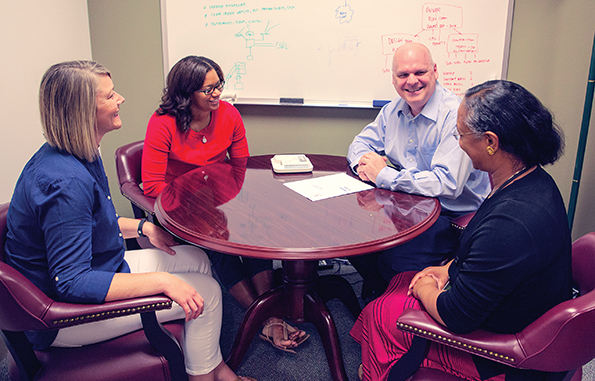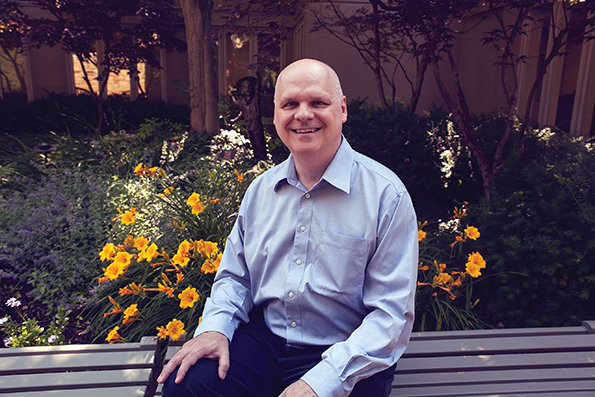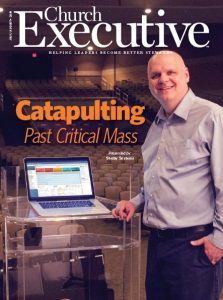
Clifton Guy, Director of Information Technology at The United Methodist Church of the Resurrection in Leawood, KS — the largest UMC in the nation — is a preacher’s kid. Two of his siblings are also pastors, as is his wife. “So, it’s kind of the ‘family business,’” he says.
But, Clifton himself is a self-professed “technical guy,” with a real interest in computers since childhood. He earned his degree in computer engineering and embarked on a 10-year career in IT software development.
He’s also an entrepreneur, having started two tech companies and served on the management team of two other startups.
Coming from a family of pastors, Guy once considered himself the proverbial black sheep. Yet, it’s exactly this passion and experience that made him uniquely prepared to be the IT director at a very entrepreneurial, large and fast-growing church: Resurrection.

Guy — who also has been part of the leadership team of The Church IT Network, with participants from many of the largest churches around the country — believes ChMS is a true ministry tool … and a major one, at that.
“The church management system is where the real value-add is — that’s where the opportunity to really make an impact on ministry resides,” he emphasizes. “There’s this real opportunity to make ministry better by using software to either automate something, or to do something you can’t do with any amount of labor. The really exciting stuff is when we’re applying technology to the unique issues of the church.”
So, Resurrection was in very good hands when it was time to upgrade its church management software platform. Here’s how Guy orchestrated an intensive, intelligent selection process … and what you need to know before making a similar investment at your own church.
I understand Resurrection outgrew its existing ChMS, prompting leaders to look for a new option. What challenges were you encountering, specifically?
Our previous ChMS was implemented in 1998, and I came on staff in 2003. In 2007, we determined that we needed to replace that system. I was involved in evaluating lots of options.
A lot of the issues with previous ChMS had to do with the user interface; it didn’t really follow any of the traditional Microsoft user interface guidelines about how to use various kinds of controls on the screen. So, people who knew how to use Microsoft software had issues navigating the ChMS. It didn’t follow the paradigms they were used to.
In general, it wasn’t designed to handle the hundreds of thousands — and in some aspects, millions — of records in our church database. It wasn’t efficient in running certain kinds of reports.
With these challenges at the forefront, we did a very extensive, thorough and careful evaluation of alternatives. It took about three months and involved two things.
First, we did extensive requirements-gathering. We developed a questionnaire and had meetings with staff throughout the organization, asking them all the same set of questions. This helped us to document, in detail, our requirements.
The second aspect was networking with lots of vendors. We connected with their salespeople. Additionally, we established a set of five criteria by which we would judge the finalists. We invited those vendors to give extensive, in-person demos of their products for a small group of church staff we called “super-users.”
Through that process, we narrowed down the list of choices to eight products. From there, we were able to narrow it to three, and then did some gap analysis on the functionalities those products delivered relative to our requirements.
It was quite an extensive, thorough and careful evaluation. Ultimately, we settled on the Shelby Arena Premium product.
What functionalities made Arena the right choice for Resurrection?
For us, one of the key issues was the architectural differences in the products. At the time, the business model of one of our three finalists was to host the system on their servers. So, any access to our data would be mediated by whatever reporting they provided, or by whatever APIs they might publish that we could then connect to in order to access the data.
But, we knew we wanted to be able to run a Microsoft SQL Server in our own data center at the church. This would allow us to have the data present onsite, as well as the ability to use the entire range of powerful tools the SQL Server provides to drive insights out of that data. We just didn’t really want somebody else’s product to mediate our access to our own data.
 I’m told your team at Resurrection considered customized reports (driven by customized dashboards) another key functionality. Can you tell us what those look like — and what these tools can tell you about the church’s ministry efforts?
I’m told your team at Resurrection considered customized reports (driven by customized dashboards) another key functionality. Can you tell us what those look like — and what these tools can tell you about the church’s ministry efforts?
We do some pretty cool stuff, and I could talk about it for hours. But, I’ll just give you a few examples. Some of these happen weekly; others happen annually or at different intervals.
When we wanted to know if there’s a correlation between the duration of a household’s membership and their giving habits, we found out. This was because we can drill into the data. And, as it turns out, at Resurrection there isn’t a correlation!
What we did find was a correlation between age and giving habits — specifically, the older people are, the more they give. And then, as they approach a certain age, their giving declines (somewhere around the upper 70’s, if I remember correctly).
So, if somebody just joined our church recently, but they’re in their 60’s, they’re likely to give more than someone who’s been a member for 15 years and is in their 40’s. That’s just one example of the sort of thing we’re able to do because we can use all the software’s analytical tools directly against that data set.
We also do some really interesting work around membership attendance data. It’s quite unusual for a church of our size to take worship attendance. In fact — though I’m not 100-percent sure — it’s possible that nobody as big as Resurrection does it. We use paper forms and an army of volunteers. For most churches, just the thought of the effort required to collect that data is so daunting that they dismiss it altogether.
But, for us, attendance data is something we’ve always placed a high priority on, primarily because we can do lots of really interesting things with it. For example, if your family is a member, and you or someone else in the family doesn’t attend worship service for four weeks, we have a report that will inform our discipleship team. If we have your phone number, a volunteer will call and ask if everything is OK — if you or your family needs pastoral care. Frequently, we find there’s a new baby in the family, or people are just on vacation.
If we can’t call, then we send an email. Failing that, we’ll send a paper letter to check in.
That’s a good example of a ministry effort you can’t do without attendance data.
Once a year (around August), we take a look at anybody we haven’t seen in worship for 13 weeks. These are the individuals who’ve basically dropped out for the summer. Then, we make a special effort to invite them to all our ministry offerings that kick off as the school year begins — activities for adults, kids and youth, special sermons series, and so on.
All these are possible because, first, we have the data. Second, we have the powerful reporting capabilities to define exactly the set of people we’re interested in talking to, define the process, and then perform it.
Does Resurrection’s multisite model make ChMS data accessibility a priority? If so, did it ultimately affect your selection?

We’ve adopted a basic approach to multisite data that’s pretty similar to what lots of other large churches do: basically, we consider ourselves to be one church in multiple locations. Because of the data at hand, we can allocate giving by campus. We can get idea of whether the folks attending a particular campus are giving enough money to support the cost of that campus. We can also tell if one person, or a family, is consistently attending a particular campus — or a particular worship service, even, because we go all the way down to that level in our attendance tracking. And then, we can tell if they’ve actually changed campuses.
That last part is really interesting to our executive management, especially if it seems like we’ve had dip in attendance. We want to know what’s driving that. We might drill into the data and discover we’ve got a new pastor at a particular campus. Then, over the course of the next several months, we see families shifting to that location. That stuff is fascinating to the executive management team when they’re trying to determine: Is there a problem at a particular location? Or, is it just that our people are choosing to attend a location that’s closer to their house?
We’ve done that, too — looked at the people who move from one campus to another in relation to where they live. We just grab their addresses and put a bunch of push pins on a Google map. That ability is extremely helpful in interpreting the macro-data, which is just the head count and worship figures each week. Now, we have this much finer-grain data that helps us interpret it.
 So, if you see that a family doesn’t necessarily live closer to their new chosen campus, you know something else is driving them there — and it gives you an opportunity to ask about it.
So, if you see that a family doesn’t necessarily live closer to their new chosen campus, you know something else is driving them there — and it gives you an opportunity to ask about it.
That’s exactly right. They might prefer the campus pastor, or they might enjoy the worship bands better. They might like the children’s ministry. They might like the fact that it’s a smaller church. Or, it might be something else, stylistically or culturally.
Your ChMS platform has even helped the church drive generosity and fundraising, right?
Yeah. Again, we do some pretty amazing stuff in this regard. In fact, I’ve given a class on it at our annual leadership institute. I call it “the nerdy side” of financial stewardship. [laughs]
At Resurrection, we conduct an annual fundraising pledge campaign for our yearly operating budget, as well as pledge campaigns for capital needs at various campuses. We start with what we call “the target” — we determine who we’re going to ask to make a pledge. We have a set of criteria: members who are 23 and up, who live in the Kansas City Metro area, and are active — in other words, they’ve attended worship at least once in the past year. We pull all the matching data from our database, and identify all the people who fit these criteria.
Next, we identify “giving units.” Some households have more than one giving unit. For example, spouses sometimes choose to manage their giving separately. Each makes a separate income, and each makes separate contributions. So, even though it’s one household, it’s two giving units.
Then, that’s the list of folks we’re going to ask to make a pledge. We do have some attrition due to death, relocation, marriage and so on. Then, we set the list and don’t add anyone to it.
Throughout the campaign, we have a baseline for tracking how we’re doing. Once the pledge cards come in, we can see who has pledged and who hasn’t. Then, we can follow up.
Now, this is a fairly traditional approach that lots of churches take. We take it farther because we segment the target by giving level. We look at the past 12 months — How much money has this giving unit given? — and put them in different segments. Now, when we get the pledges back, we can actually tell if, for example, we haven’t heard from 25 percent of the people in our top segment.
Then, we do even more analysis on the pledges. We look at their pledge versus their pledge for the prior year. We also break down the data by whether or not this is a new pledge — if these folks have never made a pledge before — or if they’re renewing a pledge. And if they are renewing, is it for less money, for the same amount of money, or for more money? This is possible because of the analytical tools inherent to Arena and our SQL Server.
As the church continues to grow, is your ChMS platform equipped to grow with you?
I don’t think any church uses its software to its full capabilities. I’m sure we don’t, here. So, the question is more: Does the software automate the things we really need automated? And also: Does it allow us to do the kinds of analytics that we need to do? Because of a very careful selection process, we can answer ‘yes’ to both.
In the future, will there be other products that potentially offer new features we haven’t considered or wanted before? Maybe. Probably.
Will there be other systems that are more flexible in terms of how new software could be built or integrated? Maybe. Probably.
But, because our software platform is based on a Microsoft SQL Server, it really isn’t limited in any way. Our church could grow to be much bigger than it is, and this platform would be capable of not only housing that quantity of data, but also reporting against it, all with reasonable speed. Certainly, the software and SQL Server we have in place is capable of supporting a very large church with millions of records in the database, like we have — or even more.
QUICK FACTS ABOUT RESURRECTION
Year Established: 1990
Location of main campus: Leawood, KS
Number of locations: 4
Number of staff (full- and part-time): 220
Combined weekend attendance: 11,300
2016 budget: $22 million
Is there anything about the implementation or training process you would do differently?
I do wish we could provide more ongoing training as a church. Like every growing organization, we have turnover; new people are constantly coming on the staff. Fortunately, Arena is fairly intuitive and self-explanatory. Even so, I wish we could accelerate their understanding and maybe show them some capabilities that would make their lives a bit better.
It’s just that there are only so many hours in the day, and we haven’t prioritized ongoing training the way we did when we first did the software implementation. We really had a very smooth transition to Arena.
For any church leader, I would highly recommend including training as an integral part of a major technology implementation. The part where we’ve been weak, as a church, is in ongoing training, not initial training.
— Reporting by RaeAnn Slaybaugh


